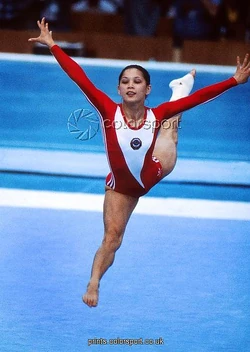| Nellie Kim | |
|---|---|
 Kim at the 1980 Olympic Games | |
|
Full name |
Nellie Vladimirovna Kim |
|
Country represented |
|
|
Born |
July 29 1957 |
|
Current status |
Retired |
Nellie Vladimirovna Kim (Russian: Нелли Владимировна Ким; born 29 July 1957) is a retired Soviet gymnast who won three gold medals and a silver medal at the 1976 Summer Olympics in Montreal, and two gold medals at the 1980 Summer Olympics. She was the first woman in Olympic history to earn a perfect 10 score on the vault and the first to earn it on the floor exercise, rivaling Nadia Comăneci, Ludmilla Tourischeva, and other strong competitors of the 1970s. Nellie Kim worked for a long time as a coach, training several national teams, and judged many major international competitions. As President of the Women's Artistic Gymnastics Technical Committee, she coordinates the introduction of new rules in women's gymnastics, as provided by the new Code of Points, developed by the FIG in 2004–2005 and in effect since 2006.
Early Life[]
Nellie Kim was born in Shurab, Tajik SSR, Soviet Union. the daughter of a Sakhalin Korean father, Vladimir Kim, and a Tatar mother, Alfiya. Later the family moved to Kazakh SSR, where her father worked in the Chimkent slate factory. At age 9, she entered Chimkent City Children and Youth Sports School 3 of the Spartak Sports Society. Two other children in the family, her younger brother Alexander and her sister Irina, also entered a gymnastics school and trained for some time. Alexander was harassed by his classmates in the secondary school for his small stature and retired from gymnastics in favor of boxing. Irina, whom Nellie Kim considered more talented than she herself was, retired because of the demands of the frequent training sessions.
Kim's trainers were Vladimir Baidin and his wife, Galina Barkova. Initially, she did not have sufficient flexibility as compared with many of her fellow gymnasts, but she was soon able to compensate with superior technique and the difficulty of her exercises. So she quickly became the best in Kazakhstan gymnastics.
One of Kim's earliest successes was her victory in the republican Spartak's competition, held in Chimkent in 1969. Nevertheless, a year later she was said to "have no future" by celebrated gymnast Larisa Latynina. After that verdict, Kim was close to leaving gymnastics but persevered with support from Baidin. At the 1971 Junior USSR Championships, her first national competition, she placed fifth in the all-around. The national junior success, as well as senior national and international debuts followed two years later. Kim won the all-around title and two more gold medals at the All-Union Youth Sports Games, placed 8th in the all-around and 1st on the uneven bars at the USSR Cup and won the prestigious Chunichi Cup in Japan. After a second-place finish at the USSR Cup in August 1974, she was added to the team roster for the World Championships, held in October, where Kim earned the gold medal in the team competition. Afterwards, and until 1980, she successfully competed in many top-level international events.
Nellie Kim's nickname among USSR teammates and team coaches was "Kimanellie," which she earned, when a trainer Vladislav Rastorotsky called her very quickly: "Kim, Nellie, to the phone!"
Olympics and World Championships[]
Nellie Kim became one of the main medal prospects for the upcoming Olympics and actual leader of the Soviet team after the 1975 Canadian Pre-Olympics Test competition. At the Test she placed second in the all-around to Nadia Comăneci, but won three golds in the event finals (vault, balance beam, floor exercise), while Comaneci won the remaining one on bars. Larisa Latynina, who had already changed her opinion about Kim earlier, described her gymnastics style as sparkling and cheerful. She also cited a comment by Canadian newspapers about Kim's performance: "There are moments, when a natural smile is more worth, than triumph". However, although Nellie Kim also won the 1976 USSR Cup, beating such famous of her compatriots as Olga Korbut and Ludmilla Tourischeva, they were still considered leaders by the media. Even the Coach Council of the Soviet team failed to define her as the leader. That was a mistake recognized by Soviet experts later. At the 1976 Summer Olympics the rivalry between Nellie Kim and Nadia Comăneci became the focal point of the women's gymnastics competition. Kim's teammates Ludmilla Tourischeva and Olga Korbut, the Olympic champions of Munich, were overcome by the two rising stars in the battle for the gold. Nellie Kim won three gold medals, one in the team competition and two in the event finals: on the vault and floor exercise. Music for her floor routine, choreographed by Valentina Kosolapova, was a fiery Samba, and one of the elements was the double back salto, performed for the first time in Olympic women's events. Kim also won a silver medal in the all-around, receiving the perfect 10 for the Tsukahara vault with the full twist, which was also performed for the first time in Olympic history. She was praised for her feminine beauty and the flamboyant, graceful and intense style. Comaneci won the gold in the all-around, on bars and balance beam. But despite being the World bronze medallist on beam Nellie performed very poorly on that apparatus conceding a full 1.0 to Nadia.
After the 1976 Summer Olympics Nellie Kim moved to Byelorussian SSR (joining the Armed Forces sports society in Minsk) and represented her new home on the USSR team. Two years later Kim successfully competed at the World Championships. She won gold medals on the vault, floor exercise and in the team competition, and placed second in the all-around to Elena Mukhina, overcoming Nadia Comăneci, who fell from the uneven bars, among others. The greatest success came at the 1979 World Championships, where Nellie Kim became the all-around champion, beating Maxi Gnauck, Melita Ruhn and her teammate Maria Filatova. Her floor exercise routine, choreographed by Galina Savarina, was accompanied by a new piece of music, House of the Rising Sun by Santa Esmeralda, which would also be used one year later at the Olympics.
In 1980 she won the all-around title at the USSR Championships and successfully competed in the Moscow Olympics, her last competitive performance. She tied for the gold medal on the floor with Nadia Comăneci, after scoring 9.95 in that event finals, and won gold in the team competition.
Her gymnastic appearances are remembered for "her strong feminine, temperamental and charismatic appeal".
Medal Count[]
| Year | Event | TF | AA | VT | UB | BB | FX |
|---|---|---|---|---|---|---|---|
| 1971 | Junior USSR Championships | 5 | |||||
| 1972 | Junior USSR Championships | 2nd | 1st | 1st | |||
| 1973 | All-Union Youth Sports Games | 1st | |||||
| USSR Cup (April) | 5 | 2nd | 1st | ||||
| USSR Cup (September) | 2nd | ||||||
| Chunichi Cup | 1st | ||||||
| 1974 | USSR Cup | 6 | 2nd | 2nd | |||
| USSR Championships | 6 | 3rd | 2nd | 2nd | |||
| Riga International | 2nd | 3rd | 1st | 1st | 2nd | ||
| Varna World Championships | 1st | 3rd | |||||
| 1975 | Pre-Olympic Test Event | 2nd | 1st | 1st | 1st | ||
| Chunichi Cup | 4 | ||||||
| USSR Cup | 2nd | ||||||
| USSR Championships | 6 | 1st | 2nd | 1st | 1st | 1st | |
| 1976 | USSR Cup | 1st | 1st | 2nd | 1st | ||
| Montreal Olympic Games | 1st | 2nd | 1st | 1st | |||
| 1978 | Strasbourg World Championships | 1st | 2nd | 1st | 1st | ||
| USSR Cup | 16 | 2nd | |||||
| 1979 | Fort Worth World Championships | 2nd | 3rd | 2nd | 2nd | ||
| USSR Championships | 2nd | 5 | 2nd | 2nd | 4 | 1st | |
| 1980 | Moscow Olympic Games | 1st | 1st | ||||
| USSR Championships | 2nd | 1st |
